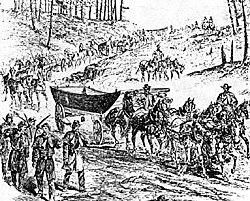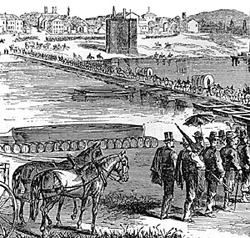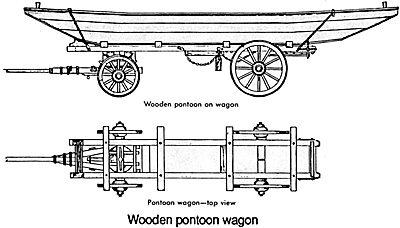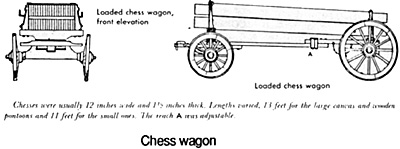 Pontoon bridges were used extensively by both UNION and CONFEDERATE armies during the American Civil War. The UNION army made greater use of pontoon bridges in much the same way as other more technical forms of warfare, e.g. the use of tactical telegraph, gunboats etc.
Pontoon bridges were used extensively by both UNION and CONFEDERATE armies during the American Civil War. The UNION army made greater use of pontoon bridges in much the same way as other more technical forms of warfare, e.g. the use of tactical telegraph, gunboats etc.
At the battle of CHANCELLORSVILLE, five pontoon bridges were built across the Rapidan River in two hours by UNION engineers (1). Later on they were dismantled and moved elsewhere. In the Western theatre they were often constructed overnight across the extensive river and creek systems that existed (2). While pontoon bridges were usually deployed strategically, they were often constructed under fire, sometimes in the lead up to an attack.. In the CHANCELLORSVILLE campaign their use was a key element of the UNION flanking move. By the same token pontoon bridges could slow a quick move by an army and were sometimes abandoned or left to follow up later. This lead to problems when a river ford was flooded and needed to be bridged. The pontoon train would then be required to move forward and this usually took some time (3).
A quick glance through the excellent TIME-LIFE series of books on the CIVIL WAR reveals a multitude of drawings, sketches and photographs of pontoon bridges. Also for any technical aspect of the American Civil War, "Arms and Equipment of the Civil War" by Coggins is an excellent reference.
HISTORICAL BACKGROUND
 What is a pontoon bridge and how were they used during the civil war? A typical pontoon bridge was made of prefabricated pontoons and timber to be laid out to form a bridge over water. The pontoons were usually constructed from either heavy timber or a collapsible
wooden frame, but this was not always the case. As with many things the CONFEDERATES often had to improvise with other materials. In the TENNESSEE campaign "well-caulked rice boats from nearby plantations" were used for pontoons moored by old guns and car wheels for anchors and flooring from wharves and wooden buildings (4). The pontoons of a typical pontoon train were carried on approximately thirty-four pontoon wagons. Each pontoon wagon contained ropes, oars, rowlocks, boat hooks and an anchor lashed under the rear axle. The timber was carried on twenty-two chess wagons. Four tool wagons and two travelling forge completed the pontoon train. One or more pontoon trains could be attached to an army as needed (5).
What is a pontoon bridge and how were they used during the civil war? A typical pontoon bridge was made of prefabricated pontoons and timber to be laid out to form a bridge over water. The pontoons were usually constructed from either heavy timber or a collapsible
wooden frame, but this was not always the case. As with many things the CONFEDERATES often had to improvise with other materials. In the TENNESSEE campaign "well-caulked rice boats from nearby plantations" were used for pontoons moored by old guns and car wheels for anchors and flooring from wharves and wooden buildings (4). The pontoons of a typical pontoon train were carried on approximately thirty-four pontoon wagons. Each pontoon wagon contained ropes, oars, rowlocks, boat hooks and an anchor lashed under the rear axle. The timber was carried on twenty-two chess wagons. Four tool wagons and two travelling forge completed the pontoon train. One or more pontoon trains could be attached to an army as needed (5).
Construction involved placing and anchoring the first pontoon, positioning the second pontoon and then laying out the side rails before placing the timbers down. Construction of a pontoon bridge was speeded up if whole sections were made up at the bank and then floated into position. This approach was used by UNION engineers to construct a 735 yard pontoon bridge in five and a half hours (6).
Union forces used pontoon bridges in the following campaigns, FREDERICKSBURG 1863, CINCINNATI 1861 (constructed by civilian volunteers!), CHANCELLORSVILLE 1863, SPOTSYLVANIA 1864, KENTUCKY 1864, TENNESSEE 1864. Confederate forces used pontoon bridges in the following campaigns, SAVANNAH 1864, TENNESSEE 1864. Those campaigns mentioned are only a representative sample and doubtless they were used elsewhere.
USING A PONTOON BRIDGE ON THE WARGAMES TABLE
Having briefly outlined how pontoon bridges were historically used, how can they be represented on the wargames table. The following suggestions are mainly aimed at BRIGADE sets of rules such as ON TO RICHMOND but can easily be adapted to smaller scale rules such as STARS*N*BARS and JOHNNY REB.
1. In the turn after the pontoon train has reached the edge of the water obstacle a pontoon bridge is constructed as follows:
- Turn 1 Place pontoon # 1 (THIRTY MINUTES)
Turn 2 Place a 100 yards section (THIRTY MINUTES)
Turn 3 Place pontoon # 2 (THIRTY MINUTES)
Turn 4 Place a 100 yards section (THIRTY MINUTES) and so on
2. Once constructed roll 2 six sided dice each turn to see if bridge collapses due to rotten wood/rope. A score of 2 and the bridge collapses.
3. If bridge construction is not supervised by engineers each action should take two turns. Engineers assisted by troops take 2 turns to complete three turns worth of building.
4. Troops working on a bridge should be treated as PRONE SKIRMISHERS if fired upon. Bridges are made impassable after one artillery hit and are destroyed after two hits. Repairs can be effected by replacing that segment of the bridge. Only collapsible pontoons can be sunk by small arms fire as above for artillery.
5. A bridging unit should be represented on the table by three wagons:
- (a) Pontoon wagon model - represents 34 pontoon wagons, ropes, oars etc.
(b) Chess wagon model - represents 22 chess wagons carrying the planking.
(c) Tool wagon model - represents 4 tool wagons, two travelling forges and supply wagons.
6. Pontoons can be either:
- (a) Light collapsible - less space, increased capacity more easily deployed but more likely to collapse; OR
(b) Heavy wooden - more space, less capacity, not easily deployed but less likely to collapse. The rules as stated above are for collapsible pontoons. Wooden pontoons or improvised pontoons add 1 turn (30 minutes) per action.
7. Pontoons can also be used as improvised boats. Each pontoon can carry one regiment of infantry (approximately 300 men) or one stand in OTR. Movement is 100 yards per turn. Pontoons can have holes shot in them by small arms fire. These troops are considered as PRONE SKIRMISHERS. A hit sinks the pontoon and remove the stand.
8. Engineers, pioneers and civilian volunteers are represented by four stands based as for dismounted cavalry (approximately 800 men).
MODELLING A PONTOON TRAIN
Once the necessary rules interpretations have been made to allow the use of pontoon bridges in your favorite rules set you'll need to construct models and figures to use on the table. "Arms and Equipment of the Civil War" provides excellent top and side views of a pontoon wagon, chess wagon and pontoon bridge. As they are in the book they can be used directly as a guide to constructing a pontoon train in 25mm. For 15mm armies you will need to reduce the drawings on a photocopier. For those people who do not have access to this book, I have included 15mm views.
 (a) Pontoon wagon - The first model to construct is the pontoon wagon. In my games this will represent approximately seventeen actual pontoon wagons. This scale may seem excessive but once horse teams are placed at the head of this model it should occupy about the same roads space as the real thing (approximately 600 yards). Choose a wagon from any 15mm range, remove the wagon body but retain the wheels and chassis. Using matchsticks or balsa build a frame to place the pontoons on. The pontoons can be constructed from balsa wood but are best made from iceblock sticks glued on top of each other, allowed to dry and then cut to shape. Without actual colors to work on I paint these a red-brown color. The finished pontoon is then placed loosely on top. At least two of these are required.
(a) Pontoon wagon - The first model to construct is the pontoon wagon. In my games this will represent approximately seventeen actual pontoon wagons. This scale may seem excessive but once horse teams are placed at the head of this model it should occupy about the same roads space as the real thing (approximately 600 yards). Choose a wagon from any 15mm range, remove the wagon body but retain the wheels and chassis. Using matchsticks or balsa build a frame to place the pontoons on. The pontoons can be constructed from balsa wood but are best made from iceblock sticks glued on top of each other, allowed to dry and then cut to shape. Without actual colors to work on I paint these a red-brown color. The finished pontoon is then placed loosely on top. At least two of these are required.
 (b) Chess Wagon - A chess wagon is constructed in a similar fashion to a pontoon wagon but with a stack of planks placed loosely on top. Once again, ice-block sticks or balsa could be used.
(b) Chess Wagon - A chess wagon is constructed in a similar fashion to a pontoon wagon but with a stack of planks placed loosely on top. Once again, ice-block sticks or balsa could be used.
(c) Tool Wagon - A single covered wagon model will do to represent the tool wagons, forges, and supply wagons.
(d) The Pontoon bridge - The pontoon bridge should be modular to allow gradual construction in the game. The pontoons from the pontoon wagon and others should be used. One pontoon is needed for each bridge segment. Bridge segments should be 1 1/2" long and fit together. In the scale that I use for my games this represents aboutl5O yards.
As described in this article pontoon bridges were widely used by both Union and Confederate forces. Every civil war miniature army should therefore have a pontoon train and if nothing else will make an interesting modelling project.
REFERENCES
1. TIME-LIFE "Rebels Resurgent", p18.
2. TIME-LIFE "War on the Mississippi", p127.
3. TIME-LIFE "The Struggle for Tennessee", p 96.
4. TIME-LIFE "The struggle for Tennessee", p 158.
5. Coggins "Arms and Equipment of the Civil War", p104.
6. Coggins "Arms and Equipment of the Civil War", p105.
Back to The Zouave Vol V No. 2 Table of Contents
Back to The Zouave List of Issues
Back to Master Magazine List
© Copyright 1991 The American Civil War Society
This article appears in MagWeb (Magazine Web) on the Internet World Wide Web.
Other military history articles and gaming articles are available at http://www.magweb.com